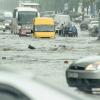
IIASA is developing new ways to explore the economics of disruptive change, casting light on our responses to pandemics and natural disasters.
Most economic analyses deal with gradual change. It cannot handle sudden shocks, be they disasters or positive regime-changes such as technological breakthroughs. The Economic Frontiers Program at IIASA is trying to understand the economics of disruptive change. One of its main tools is an innovative optimization-modeling framework. Unlike other such models, this can accommodate sudden changes – including those originating from within the system – and then trace out implications both before and after the change.
IIASA researchers have used the model to look at how households respond to flood risk. While an individual household can’t affect the likelihood of flooding, they might reduce their exposure by relocating to a place with lower flood hazard. Alternatively, they might reduce the impact of flooding through physical flood protection measures, through insurance, or by saving for a rainy day. The model identifies optimal choices depending on household income, education, and other socioeconomic factors. It is calibrated with data from Thailand and Vietnam.
“We find that the better educated make better choices in the face of flood risks, as measured by the overall wellbeing they can expect,” says Michael Freiberger, a researcher in the Economic Frontiers Program, who leads this project. The positive effect of education remains even when accounting for other correlated factors such as risk awareness and income.
When the modeling framework was adapted to analyze COVID lockdown strategies, it produced a surprising result. Working with researchers at the University of Padua in Italy, IIASA scientists calculated the optimal degree of lockdown over time, weighing the value of lives lost against economic losses. Unlike previous epidemiological modeling studies, this work includes the arrival of a vaccine, and allows for uncertainty about when the vaccine will be developed and approved.
With realistic numbers for the vaccine’s effectiveness and rollout time, the model’s optimal strategy is actually to increase the intensity of lockdown measures when a vaccine is approved. Although this was unexpected, it makes sense in hindsight. The stricter lockdown measures protect the most vulnerable from getting ill before they receive the vaccine, but is less expensive than maintaining an intense lockdown for a long time while hoping for a vaccine breakthrough.
The result may be too late to help current COVID policy, but it provides a general insight into how vaccines and lockdowns tie in.
“Unfortunately, COVID is probably not the last big pandemic risk we will face, and any knowledge generated during this experience could help to inform better policy responses in the future,” says Economic Frontiers Program Director, Michael Kuhn.
The team will extend the model to learn how the emergence of new virus variants should shape pandemic policy. The new framework can deal with a wide range of problems. It promises to provide deep insights into resilience – how societies and other systems recover from shocks – and because it can reveal the overall effectiveness of different strategies before and after a disruption, it should be able to weigh tradeoffs between climate adaptation and mitigation.

